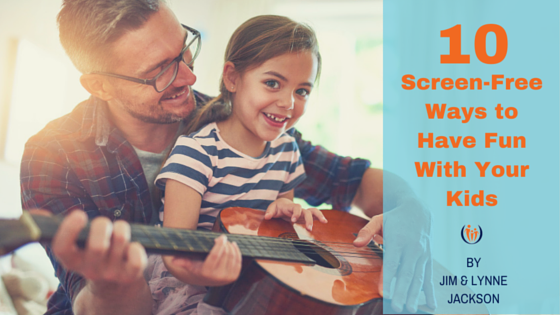
10 Screen-Free Ways to Have Fun With Your Kids
We have talked before about some “DOs and DON’Ts” of how to peel your kids off the screen. It may seem difficult to help your kids discover fun alternatives to their action-packed video games or TV shows, but it can be done! It will take some intentionality on your part, of course, but making the goal of a memory-filled summer in which relationships are enriched will be worth your time and effort. Check out this list of ways to have fun with your kids — no screens required!
1. Play with your kids!
Everything listed below will dramatically increase in its value when you do it together with your kids.
2. Arts & Crafts.
A variety of simple art and craft supplies is easy to collect, since many crafts use everyday household items. There are also hundreds of fun (and often inexpensive) craft ideas on websites like Pinterest or Family Fun. Help your kids learn to look for craft ideas, make a list of supplies, and give them a modest budget.
3. Storytime.
According to author Stephen King, “Books are a uniquely portable magic.” They can travel anywhere physically, and they help your kids travel anywhere in their or the author’s imagination! Plus, lots of reading time with Mom and Dad helps to model the importance of education, AND gives you time to imagine together with your child! Or, if books aren’t your thing, make up your own stories! Find a picture in a magazine or some Story Cubes and start inventing worlds!
4. Costume box.
A costume box can easily be assembled from hand-me-downs, garage sale oddities, or whatever interesting drama supplies you find lying around. Our kids would play for hours as they wrote, directed, and acted in their own impromptu skits with their friends. They even filmed a few productions, including this awesome school project and another family classic — “James Blond”. As you can see, this was not just a “girl thing” – our kids developed quite the selection of warrior costumes, complete with foam swords. (We accepted some aggressive elements in favor of 3-D creativity, and calmly intervened if it got beyond our comfort level.)
5. Creative board games.
Sometimes encouraging creativity can be as simple as choosing a board game that stimulates quick creative thought (such as Pictionary, Charades, or Scattergories) or problem-solving and strategy (like Stratego, Risk, or Labyrinth).
6. “Odds-n-ends” box.
An “odds-n-ends” box can contain anything you want — interesting household “junk”, artifacts from nature walks, packaging materials and containers, anything! These “treasures” can be used for craft projects, making your own “I Spy” game, or any other creative endeavor that comes to mind. One of our daughter-in-law’s most vivid memories of kindergarten is looking through a box full of old keys of all sizes, shapes, and colors every day at playtime.
7. Journaling or Scrapbooking.
Journaling is a great way for kids to process their thoughts and emotions and just spend a little time calming down and getting to know themselves. Additionally, research suggests journaling may benefit overall health. Scrapbooking is another fairly calm, creative activity that you could do together. Either option can be a fun way for your child to look back on past experiences and record their memories.
8. “Rough-and-tumble” area.
Children who are “movers and shakers” may be uninterested in many of the things on this list. But fill a room with pillows, balls, a mini-trampoline, and an empty barrel to ride on or roll in, and they can be entertained for hours! A physical outlet can also provide a healthy alternative for a child that tends to get lost in screen activities. When provided with a playroom where he could climb and swing, Derek said, “Now my brain isn’t turning into mush, because I like doing this stuff even more than playing video games!” Resources for fun equipment include Flaghouse.com, Abilitations.com or Play With a Purpose.
9. Music.
Music can be an expressive outlet for kids (and adults!) of all ages. Start out with simple instruments, like shakers or drums, and let your children experiment with different types of music. A sound recorder or an old movie camera can allow them to make their own “CDs” and “music videos”. When the toddler who lived with us showed a tendency to hit things with sticks, we got him some kids’ drumsticks and made some “shakers” out of baby food jars and dry rice. Not only did he love them, but he continues to show a gift for percussion!
10. Prioritize children’s discovery.
One morning five-year-old Bethany dressed in quite a unique outfit. Resisting the temptation to pass on a few fashion tips, Lynne said, “My, that flowered shirt and striped pants are an interesting combination.” Bethany confidently announced, “Yup. This is the beginning of a lifetime of creative dressing!” Sometimes we adults can become impatient with kids’ attempts to explore or be creative. We may get frustrated with messes after a creative session or “take over” when we feel kids are progressing too slowly. But guiding your children with thoughtful questions instead of jumping in with the “right way” can build their creativity and their confidence as they learn to express themselves.
APPLY IT NOW:
The above suggestions can be a launching pad to think outside the box as I consider the natural interests and gifts of my children. What one or two things could I do to facilitate creativity in our home?
Sign up below to receive a weekly dose of encouragement straight to your inbox:

